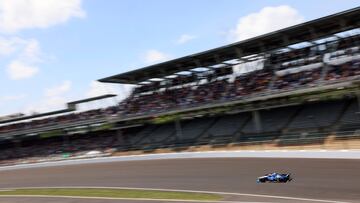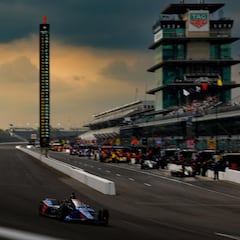The brickyard legacy: Why Indianapolis Motor Speedway’s name is cemented in history
The Indianapolis Motor Speedway has witnessed decades of tradition and tributes, including “kissing the bricks,” but what’s the secret behind those bricks?

The historic 2.5-mile track at Indianapolis Motor Speedway has over 100 years of racing history. Located in a suburb of Indianapolis, Indiana, the enormous track was built in 1909 and was the second purpose-built track of its kind.
The main events hosted there include the Indy 500, the most prestigious event in the IndyCar calendar, and the Verizon 200, a NASCAR event. Formula 1 US Grand Prix and Moto GP events were also hosted there.
But why is the Speedway track referred to as the Brickyard? Let’s break it down.
Why is the Indianapolis Speedway called the Brickyard?
The Speedway has been nicknamed the Brickyard since 1909 simply because the track’s original surface was paved with bricks.
Bubba at the Brickyard 🤩
— Indianapolis Motor Speedway (@IMS) May 21, 2025
Thanks for stopping by to Kiss The Bricks before the #Indy500, @bubbawatson! 😘 🧱 pic.twitter.com/GzrrOwq1pX
When the speedway was first born, the track’s original surface was created from “a sticky amalgam of gravel, limestone, tar, and 220,000 gallons of asphaltum oil,” according to sources. This turned out to be a fatal problem that killed five people in the first car race at the track, with ‘flying gravel shattering goggles and bloodied cheeks.”
The track owner, Carl Fisher, repaved it with 3.2 million bricks over 63 days that same year.
In 1938, the whole track was paved with asphalt except for the middle portion of the front straightaway.
The remaining bricks on the front straightaway were then covered with asphalt in October 1961, and a 36-inch strip of the original bricks were kept untouched at the start/finish line.
The bricks remain intact today as the fabled Yard of Bricks, and continue past the literal track and into the infield.
Why do drivers kiss the Yard of Bricks?
So many elements of the track’s Indy 500 history come down to tradition, and one of those includes the Indy 500 winner or NASCAR race winner “kissing the bricks.”
The tradition began in 1996 when NASCAR champion Dale Jarrett kneeled and kissed the Yard of Bricks after his Brickyard 400 victory to pay tribute to the fabled history of the Indianapolis Motor Speedway.
Related stories
The team then joined Jarrett for a group kiss on the bricks, and the Indianapolis tradition was born.



Complete your personal details to comment